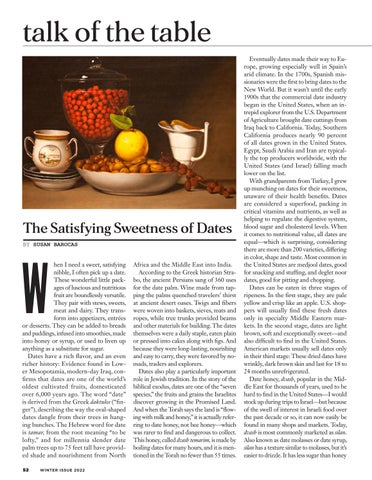talk of the table
The Satisfying Sweetness of Dates BY SUSAN BAROCAS
W
hen I need a sweet, satisfying nibble, I often pick up a date. These wonderful little packages of luscious and nutritious fruit are boundlessly versatile. They pair with stews, sweets, meat and dairy. They transform into appetizers, entrées or desserts. They can be added to breads and puddings, infused into smoothies, made into honey or syrup, or used to liven up anything as a substitute for sugar. Dates have a rich flavor, and an even richer history: Evidence found in Lower Mesopotamia, modern-day Iraq, confirms that dates are one of the world’s oldest cultivated fruits, domesticated over 6,000 years ago. The word “date” is derived from the Greek daktulos (“finger”), describing the way the oval-shaped dates dangle from their trees in hanging bunches. The Hebrew word for date is tamar, from the root meaning “to be lofty,” and for millennia slender date palm trees up to 75 feet tall have provided shade and nourishment from North 52
WINTER ISSUE 2022
Africa and the Middle East into India. According to the Greek historian Strabo, the ancient Persians sang of 360 uses for the date palm. Wine made from tapping the palms quenched travelers’ thirst at ancient desert oases. Twigs and fibers were woven into baskets, sieves, mats and ropes, while tree trunks provided beams and other materials for building. The dates themselves were a daily staple, eaten plain or pressed into cakes along with figs. And because they were long-lasting, nourishing and easy to carry, they were favored by nomads, traders and explorers. Dates also play a particularly important role in Jewish tradition. In the story of the biblical exodus, dates are one of the “seven species,” the fruits and grains the Israelites discover growing in the Promised Land. And when the Torah says the land is “flowing with milk and honey,” it is actually referring to date honey, not bee honey—which was rarer to find and dangerous to collect. This honey, called dvash temarim, is made by boiling dates for many hours, and it is mentioned in the Torah no fewer than 55 times.
Eventually dates made their way to Europe, growing especially well in Spain’s arid climate. In the 1700s, Spanish missionaries were the first to bring dates to the New World. But it wasn’t until the early 1900s that the commercial date industry began in the United States, when an intrepid explorer from the U.S. Department of Agriculture brought date cuttings from Iraq back to California. Today, Southern California produces nearly 90 percent of all dates grown in the United States. Egypt, Saudi Arabia and Iran are typically the top producers worldwide, with the United States (and Israel) falling much lower on the list. With grandparents from Turkey, I grew up munching on dates for their sweetness, unaware of their health benefits. Dates are considered a superfood, packing in critical vitamins and nutrients, as well as helping to regulate the digestive system, blood sugar and cholesterol levels. When it comes to nutritional value, all dates are equal—which is surprising, considering there are more than 200 varieties, differing in color, shape and taste. Most common in the United States are medjool dates, good for snacking and stuffing, and deglet noor dates, good for pitting and chopping. Dates can be eaten in three stages of ripeness. In the first stage, they are pale yellow and crisp like an apple. U.S. shoppers will usually find these fresh dates only in specialty Middle Eastern markets. In the second stage, dates are light brown, soft and exceptionally sweet—and also difficult to find in the United States. American markets usually sell dates only in their third stage: These dried dates have wrinkly, dark brown skin and last for 18 to 24 months unrefrigerated. Date honey, dvash, popular in the Middle East for thousands of years, used to be hard to find in the United States—I would stock up during trips to Israel—but because of the swell of interest in Israeli food over the past decade or so, it can now easily be found in many shops and markets. Today, dvash is most commonly marketed as silan. Also known as date molasses or date syrup, silan has a texture similar to molasses, but it’s easier to drizzle. It has less sugar than honey











